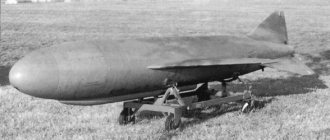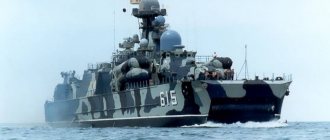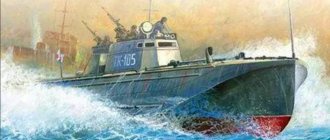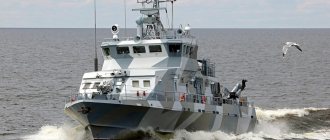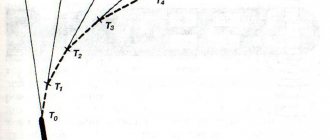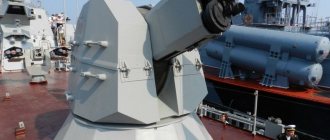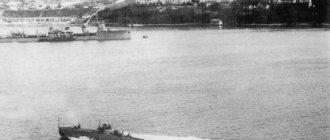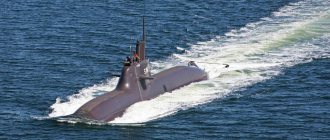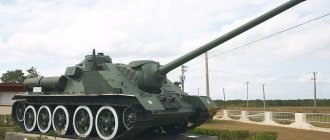Patrol boats
A patrol ship is, first of all, a class of warship. It is quite fast and has small dimensions.
The boat is designed for service in border services and performs several main tasks:
- Protects state water boundaries;
- Carries out guard and patrol service in coastal waters and on the approaches to strategically important naval bases;
- Inflicts fire strikes on other ships;
- In wartime, they guard ships and other transport, and also escort submarines.
The boat differs from other vessels, for example, heavy torpedo boats or destroyers, in its small dimensions, high speed and maneuverability, which allows the vessel to successfully carry out its assigned tasks at state borders. Due to its small size and high autonomy, it is capable of hiding in ambushes for a long time and unnoticed, quickly and almost silently intercepting and neutralizing intruders. To detect the enemy, navigation equipment and a system for determining nationality are provided on board.
Boats
Varieties
torpedo boat
Patrol boat
Raid boat
Hovercraft
Missile boat - small missile ship
Landing craft
Torpedo boat type g-5
Gunboat
Patrol boat
Estonian patrol boat EML P421
The first patrol boats
The history of the creation of a patrol boat began in the early years of the 20th century. When World War I began, there was not a single combat boat in the Russian fleet. The question was posed sharply. The fleet needed fast ships armed with cannons to patrol and fight German submarines and destroyers.
The construction of the patrol ship was carried out at the Zolotov shipyard. In 1916, the Baltic Fleet received 12 high-speed boats with wooden hulls. The boat was armed with a 47 mm cannon and a 7.62 mm machine gun. These ships took a direct part in the fighting of the First World War.
The second series of larger boats was released in 1918. The length of the hull was 19 meters. Some of the ships were sent to the Volga, where they took part in the battles for Kazan. Another one was transferred to the Kama River to transport troops and cargo fighting against Kolchak.
In the 20s In the 20th century, some representatives of patrol boats were used for border patrol. The series for mass production was developed in 1925.
History of creation
3 Project 1400M MC PV USSR
The design of patrol boats for the naval units of the border troops of the KGB of the USSR began in the mid-1960s. In 1967, at the Almaz Central Marine Design Bureau, the team of chief designer V.M. Burlakov and the chief observer from the Navy, captain 2nd rank V.I. Litovsky, created Project 1400 under the code cipher “Grif”. Boats of this type were intended to protect the state maritime border in coastal areas, straits and open roadsteads of ports, in river and lake areas, as well as to provide maritime checkpoints. In 1967-2000, about 300 boats of this type were built: at the Sea Shipyard of Feodosia (217 units), at the Batumi Shipyard and 8 at the Primorsky Shipyard. Of these, 118 were sold to 20 countries.[1][3][4]
Patrol boat “Grif” – project 1400
A patrol boat in service with the border troops of the Federal Security Service of the Russian Federation and a number of other states. Designed in the late 60s. engineers of the Almaz design bureau.
The boat was designed to perform several tasks:
- Protection of any state water borders near the shore, in straits, bays, port harbors;
- Providing maritime checkpoints;
- Participation in search and rescue operations;
- Participation in environmental control.
Patrol boat "Grif"
The Grif has small dimensions, so it can be easily transported by freight trains. Its length reaches 22 meters, and its draft is 1 meter. The vessel is equipped with two M-401 diesel engines, generators and two propellers. Maximum acceleration speed is 29-30 knots. The team consists of 10 sailors.
The boat's armament consists of:
- Navigation: radars “Lotsiya” and “Gradus-2M”, magnetic compasses;
- Radar: state recognition system "chrome-K";
- Radio electronics: radio stations;
- Artillery weapons: 2M machine gun or Utes-M machine gun mount.
Based on Project 1400, several variants were built:
- Modification "E" export boat. The ship was built for Cuba and Guinea. They also added a machine gun turret and air conditioners on board.
- The M series boat had a hull made of extremely durable metal.
- Project “A” is a boat for transporting the government of the country. All weapons on the ship have been removed.
- The ship "Gurzuf" was used as a transport vessel. All weapons on board the boat were removed.
“Made with us” and on Yandex.Zen
I bring to your attention a photo review of the ship and boat composition of the Coast Guard of the Federal Border Service of the FSB of Russia. It so happened that on the “Made with Us” website the Russian Navy receives quite a lot of attention, while the border guards remained “in the shadows.” I decided to fix this mistake!
The review does not pretend to be a reference book from which you can find out comprehensive information about all types of ships, boats and auxiliary vessels, their number and performance characteristics. However, it is possible to gain initial knowledge about the diversity and modern appearance of the ships guarding the sea and river borders of our Motherland!
1. Project 11351 border patrol ship “Nereus”:
Displacement: 3642 tons
Maximum speed: 31 knots
The ship has a landing pad for receiving a helicopter.
Border guard ships and boats had this coloring in the 90s:
2. Border patrol vessel project 850285:
Displacement: 2553/2684/2695 tons
Maximum speed: 19 knots
The ship has a landing pad for receiving a helicopter.
3. Project 1595 border support ship “Pevek”:
Displacement: 4040 tons
Maximum speed: 18 knots
4. Project 97P border patrol ship:
Displacement: 3525 tons
Maximum speed: 15 knots
The ship has a landing pad for receiving a helicopter.
5. Project 745P border patrol ship:
Displacement: 1620 tons
Maximum speed: 13 knots
6. Project 12081 border patrol ship “Slepen”:
Displacement: 450 tons
Maximum speed: 23 knots
7. Border patrol ship of project 1248/12481 “Moskit”:
Displacement: 213 tons
Maximum speed: 17.5 knots
8. Border patrol ship (control ship) of project 1249:
Displacement: 225 tons
Maximum speed: 17 knots
9. Border patrol ship of project 12412/1241PE “Molniya”:
Displacement: 475/495 tons
Maximum speed: 32.8/30.5 knots
10. Project 10410 border patrol ship “Svetlyak”:
Displacement: 375 tons
Maximum speed: 32 knots
11. Project 22460 border patrol ship “Ropit-Mars-06”:
Displacement: 670 tons
Maximum speed: 24.8 knots
The ship has a landing pad for receiving a helicopter.
12. Ice-class border patrol vessel of project 22120 “Purga”:
Displacement: 1066 tons
Maximum speed: 24 knots
The ship has a landing pad for receiving a helicopter.
13. Project 6457C border patrol vessel “Sprut”:
Displacement: 835 tons
Maximum speed: 21.5 knots
14. Project 14310/14310M border patrol ship “Mirage”:
Displacement: 120 tons
Maximum speed: 50 knots
15. Border patrol boat of project 12200 “Sobol”:
Displacement: 57.5 tons
Maximum speed: 48 knots
Pitsunda, Abkhazia, June 24, 2011:
16. Border patrol boat of project 12150 “Mongoose”:
Displacement: 27.2 tons
Maximum speed: 52 knots
In addition to the indicated types, the BO FPS FSB of Russia includes several more types of patrol boats (smaller), hovercraft, as well as a large number of auxiliary vessels for various purposes. The total number of ships, boats and vessels of all types used by border guards, incl. small-sized, reaches four hundred!
Near term.
PSKRs pr. 12412 “Molniya” - gradual decommissioning as ships of new projects arrive.
PSKRy pr. 10410 "Svetlyak" - completion of serial construction.
PSKR pr.10410 (plant No. 808) being completed at the Yaroslavl Shipyard - the 32nd ship of the series:
PSKRy pr. 22460 "Ropit-Mars-06" - serial construction at 2 shipyards - Shipbuilding (St. Petersburg) and "Eastern Shipyard" (Vladivostok).
PSKR "Brilliant" being completed at the Northern Fleet "Almaz" - 1st serial ship:
PSKA Ave. 12200 “Sobol” and 12150 “Mongoose” - continuation of serial construction.
Transportation of Sobol type PSKA from St. Petersburg to the Far East:
In the near future, the laying of the first PSKR of the new project 22100 “Ocean” should take place at the Zelenodolsk Shipyard. Border patrol ships of this type should replace PSKRs of projects 11351 and 97P.
Photos used to prepare the material:
Vladimir Sergeevich from the site russianplanes.net
I. Kazimirchik from fleetphoto.ru
Baltiec on Yandex.Photos https://fotki.yandex.ru/users/baltiec/
as well as from the sites forums.airbase.ru and docklife.ucoz.ru
The characteristics of the ships can be viewed here: https://russian-ships.info/pogran/
Description
The boat had dimensions that allowed it to be transported by rail. The main armament was a twin 2M-7 14.5 mm machine gun, located in the bow. The twin-shaft power plant consisted of two V-shaped M-401A diesel engines with a power of 1000 hp. With. every. Diesel generator DG-40 and diesel generator-compressor-pump DGKN-40. Hull with combined contours (round chine at the bow and sharp chine at the stern) made of pressed panels, sheet and profile material made of aluminum-magnesium alloys. The framing system is longitudinal with hinged frames, except for the bow, where there is a transverse framing system. The hull is welded (Project 1400 - riveted) from aluminum-magnesium alloy grade B48-4T1, which allows the use of the block method of building the ship. The hull is divided into 6 compartments by waterproof bulkheads. The boat is able to remain afloat when any compartment is flooded. The single-tier superstructure is also made of aluminum-magnesium alloys with welded or glue-welded structures. Motor control is remote automated. If necessary from the engine room.[1]
Operating countries
- USSR since 1967 more than 180[5]
- Russia 31
- Ukraine 12 for 2010[6]
- Georgia 10. Many do not have standard weapons, 2 were blown up on August 13, 2008 in Poti by units of the Russian Airborne Forces, from 1 the weapons were removed in 2012[4]
- Kazakhstan 4 projects 1400M[4]
- Estonia in 1992 2, 1 decommissioned in 2001, since May 25, 2001 as a museum in Tallinn
- Azerbaijan 1
- Turkmenistan 1 project 1400T built for Turkmenistan[4]
- Cuba in 1971-1988 40 (18 withdrawn from the fleet)
- South Yemen To South Yemen: in 1975 - 2 (withdrew from the fleet) and in 1978-1990 - 14 (4 were withdrawn from the fleet), in 1975-1988 to North Yemen - 5 (withdrawn from the fleet)
- Vietnam 14 - 3 in 1978, 3 in 1979, 1 in 1981, 3 in 1986, 2 in 1989, 2 in 1990
- Bulgaria in 1981 10
- Nicaragua in 1982-1986 8 (six withdrawn from the fleet)
- Syria 8 - 3 in 1981, 3 in 1984, 2 in 1985
- Iraq in 1974-1975 5 (removed from the fleet)
- Mozambique in 1978-1980 5 (three withdrawn from the fleet)
- Benin 4 in 1979 and 1980, 2 scrapped in 1992
- Ethiopia in 1982-1985 4 (two were withdrawn from the fleet)[5]
- Cape Verde in 1980 3 (two withdrawn from the fleet)
- Cameroon in 1985-1988 3 (2 withdrawn from the fleet)
- Republic of the Congo in 1982 3
- Equatorial Guinea in 1974-1975 3 (withdrawn from the fleet)
- Guinea in 1987 2
- Cambodia in 1988 2
- Mauritius in 1990 2
- Seychelles in 1981 and 1982 2
- Algeria in 1981 1 (withdrawn from the fleet)
- Angola in 1975 Angola 1 (withdrawn from the fleet)
- Somalia in 1974 1 (withdrawn from the fleet)
All data and information[1]
Service
The first boats were sold abroad in 1971 to Cuba and Equatorial Guinea. Out of more than three hundred boats, a little more than a hundred were exported to 23 countries in Africa, Asia and America. Estonia received two more boats after the collapse of the USSR in 1992, and several dozen hulls went to Ukraine during the division of the Black Sea Fleet (one was transferred to Georgia). To date, almost all Project 1400-M boats have been decommissioned, and as of December 2001, there are no more than four Project 1400M boats in the naval units of the Federal Border Guard Service of Russia.[1]
